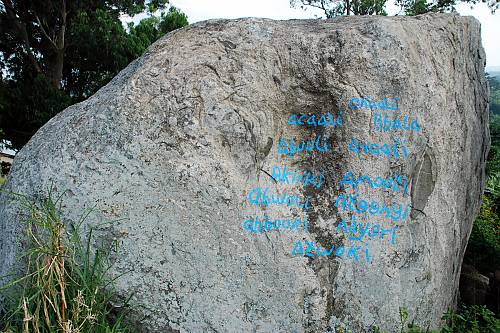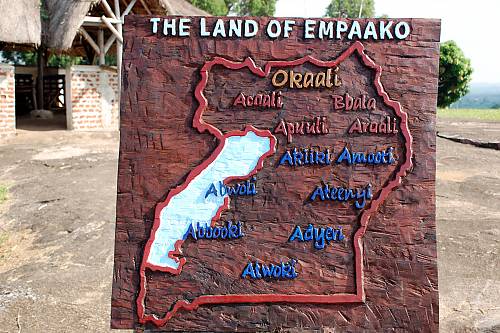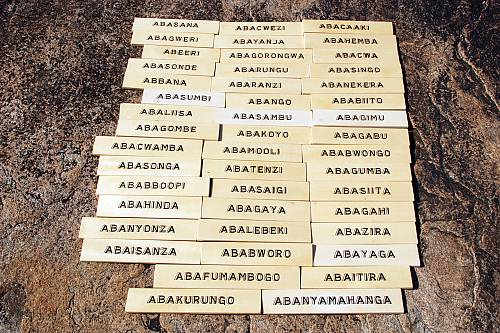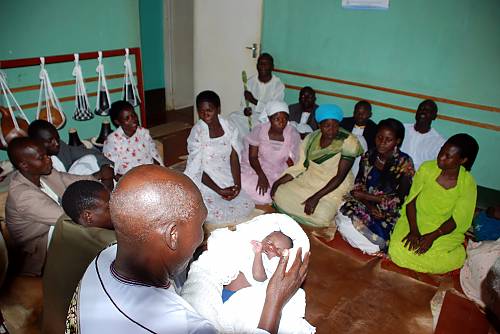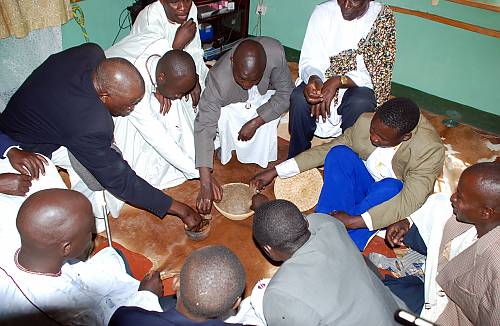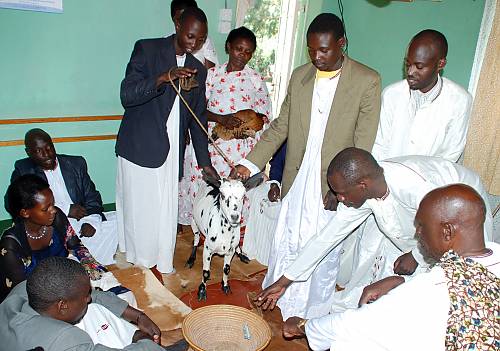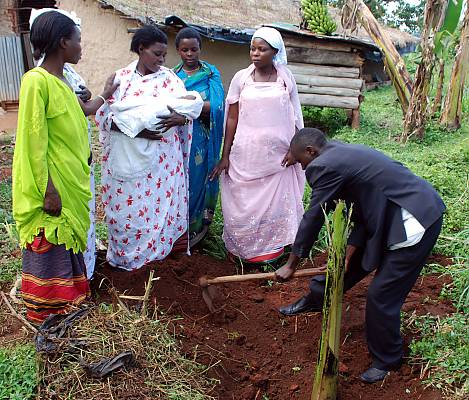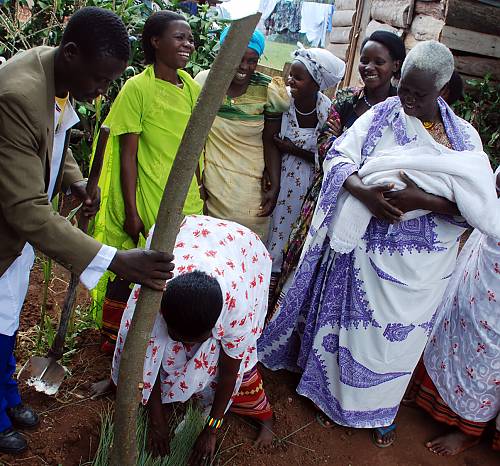Rapport sur l'état d'un élément inscrit sur la liste du patrimoine culturel immatériel nécessitant une sauvegarde urgente
A. Page de couverture
A.1.
État partie
Nom de l'État partie
Ouganda
A.2.
Date du dépôt de l'instrument de ratification, d'acceptation, d'approbation ou d'adhésion
Elle peut être consultée en ligne.
Date of deposit of the instrument of ratification, acceptance, approval or accession
2009-05-13
A.3.
Élément inscrit sur la Liste de sauvegarde urgente qui fait l'objet du présent rapport
Nom de l'élément
Empaako tradition of the Batooro, Banyoro, Batuku, Batagwenda and Banyabindi of western Uganda
Inscrit en
2013
État(s) soumissionnaire(s)
Ouganda
A.4.
Période considérée dans le présent rapport
Veuillez indiquer la période couverte par le présent rapport.
Reporting period covered by this report
01-01-2018 - 31-12-2021
A.5.
Autres éléments inscrits sur la Liste de sauvegarde urgente, le cas échéant
Veuillez établir une liste de tous les autres éléments présents sur le territoire de votre pays qui sont inscrits sur la Liste de sauvegarde urgente et indiquer en quelle année ils y ont été inscrits ; pour ce qui est des éléments multinationaux, veuillez indiquer quels autres États sont concernés.
Other elements inscribed on the Urgent Safeguarding List, if any
La cérémonie de purification des garçons chez les Lango du centre-nord de l’Ouganda (2014)
La danse et musique de lyre arquée ma’di (2016)
La tradition orale Koogere des Basongora, Banyabidi et Batooro (2015)
Le bigwala, musique de trompes en calebasse et danse du royaume du Busoga en Ouganda (2012)
A.6.
Synthèse du rapport
Veuillez fournir une synthèse du rapport, qui permette au grand public de comprendre l'état actuel de l'élément, mentionne toute incidence positive ou négative de son inscription et fasse état des mesures de sauvegarde mises en œuvre pendant la période considérée et leur possible mise à jour les années suivantes.
Executive summary of the report
This report concerns implementation of safeguarding measures for Empaako tradition of the Batooro, Banyoro, Batagwenda, Batuku and Banyabindi of Western Uganda which was, in December, 2013 inscribed on the list of intangible cultural heritage in need of urgent safeguarding. This is the 2nd ordinary report which is following the 1st which was approved in 2018 and an extra ordinary one which was approved in December, 2015.
Empaako is a naming system whereby in addition to family and given names, a child is given Empaako name selected from a fixed list of 12 of them, shared by the entire society. The use of Empaako is a declaration of respect, endearment or affection and the practice is associated with ceremonies and practices of which meaning from the basis of belief systems of concerned communities. Until the inscription in 2013, the practice was threatened by loss of knowledge of associated ceremonies, abandoning observance of these ceremonies, declining use of its language and attack from some religious groups.
A safeguarding plan which was adopted at inscription and revised immediately after, outlined capacity building of practitioners, comprehensive documentation of ceremonies and practices, mobilization of practitioners to revitalize performance of these ceremonies and raising awareness as key safeguarding measures. Others include linking the meaning of the practice to programs of environmental sustainability and peace building and contributing to the revitalization of the use of the language (Runyoro - Rutooro) where the practice thrives.
The extraordinary report which covered 16 months after inscription realized participatory review of the safeguarding plan, establishment of mechanisms for effective participation of all stakeholders and adopting an effective fundraising strategy. The first ordinary report approved in 2018, in addition to results in the extraordinary report which laid a ground for effective implementation of safeguarding measures, featured massive mobilization using radio, music, artists and online platforms. Others included success in fundraising and preparations for implementation of a big project co-funded by Intangible Cultural Heritage Fund.
The current report covers a period from January 2018 to December, 2021 and building on the previous results, highlights established capacity of practitioners to document for safeguarding and mobilized communities. Comprehensively documented and broadly disseminated knowledge of ceremonies and practices and raised awareness towards revitalization and transmission of the element to successive generations.
The future action focus on consolidation of realized results on capacity development, documentation and dissemination, linking and integration of the meaning of the practice into programs of environmental sustainability and peace building and ongoing connecting to programs for revitalization and development of the language.
A.7.
Personne à contacter pour la correspondance
Donnez le nom, l'adresse et les coordonnées d'une personne à qui toute correspondance concernant le rapport doit être adressée.
Titre (Mme/M., etc.)
Mr
Nom de famille
Rwagweri
Prénom
Stephen
Institution/fonction
Executive Director
Adresse
Engabu Za Tooro (Tooro Youth Platform for Action)
P.O. Box 886
Fort Portal
Plot 18, Kaija Road, Fort Portal - Uganda
+256 772469751
engabuzatooro@gmail.com/info@engabuzatooro.or.ug
Numéro de téléphone
+256 772469751
Adresse électronique
engabuzatooro@gmail.com
Autres informations pertinentes
B
Mr
B. État de l'élément inscrit sur la Liste de sauvegarde urgente
Veuillez vous référer au dossier de candidature ou aux précédents rapports, le cas échéant, pour savoir quand établir un rapport sur l'état actuel de l'élément et ne rendez compte que des changements pertinents survenus depuis la date de son inscription sur la Liste ou depuis le précédent rapport. Les dossiers de candidature, les calendriers spécifiques et les précédents rapports, le cas échéant, sont disponibles à l'adresse suivante : https://ich.unesco.org ou peuvent être demandés au Secrétariat.
L'État partie s'efforce de prêter une attention particulière au rôle du genre et d'assurer la plus large participation possible des communautés, des groupes et, le cas échéant, des individus concernés ainsi que des organisations non gouvernementales pertinentes pendant le processus de préparation de ce rapport ; il lui est demandé au point D ci-dessous de décrire de quelle manière il y est parvenu.
B.1.
Fonctions sociales et culturelles
Expliquez les fonctions, les significations sociales et culturelles de l'élément aujourd'hui, au sein et pour ces communautés, les caractéristiques de ses détenteurs et de ses praticiens et décrivez, entre autres, toute catégorie de personnes exerçant un rôle ou des responsabilités spécifiques vis-à-vis de l'élément. Une attention particulière devrait être accordée à tout changement pertinent susceptible d'avoir des répercussions sur le critère d’inscription U.1 (« L’élément est constitutif du patrimoine culturel immatériel tel que défini à l'article 2 de la Convention »).
Social and cultural functions
This report concerns Safeguarding Empaako Tradition of the Batooro, Banyoro, Batuku, Batagwenda and Banyabindi of Western Uganda which, in 2013, was inscribed on the list of Intangible Cultural Heritage in Need of Urgent Safeguarding.
Empaako is a naming system whereby in addition to the family and given names, children are given one name from a fixed list of 12 collectively called Empaako and shared across communities. They include Okaali which is exclusively for a king, Araali, Acaali, Bbala, and Apuuli which are exclusively for males, and Ateenyi, Akiiki, Abwoli, Atwoki, Adyeri, Amooti and Abbooki which can be given either sex.
Empaako practice is transmitted through a naming ceremony which has several rituals that have slight variations from community to community. The meaning and interpretations of the rituals are linked to the value systems of these communities. In the naming ceremony, the paternal aunties receive the baby and examine its features. Any resemblance to the living or living dead relatives forms the basis of the choice of Empaako to give the baby.
After discussion on proposals, the clan head rules and declares the chosen Empaako by addressing it directly to the baby. A shared meal of millet and smoked beef follows, gifts are presented to the baby and tree or banana is planted in its honour.
In case of a child born outside own clan or an out sider who comes to live in a community, a ceremony which involves sharing Omwani (coffee barriers) and milk and kubukara (a reception ritual involving sitting on the lap of the head of clan to receive blessings) is organized.
In greeting, the two address each other using Empaako and one asks Empaako only on first interaction. Addressing using someone’s exact Empaako, affirms that 'I know and recognize you as person' since they are only 12 shares by entire society.
The use of Empaako helps to define and categorize a web of social relationships and interactions. Addressing using Empaako to a parent, an elder, a leader, a spirit medium or god is a declaration of respect and honour and to a lover, a tender minor, a sick, a suffering, a missed or dead dear one is an expression of love or affection. Empaako is also used in expressing thanks, bidding farewell and appealing for favour from both human and super human beings.
The Empaako is used to affirm human dignity and enforce the acceptable code of social conduct. For instance when someone is found in unacceptable behaviour will be asked "Do you have Empaako? "This sends serious message of caution. In the minds of the bearer, addressing using Empaako suspends other factors in order to affirm the supremacy of the common principle of humanity. This is why addressing by Empaako has an effect of diffusing and neutralizing tension and anger and then Empaako is used as a tool in the mechanisms of community conflict mitigation and resolution.
B.2.
Analyse de sa viabilité et risques auxquels il est actuellement exposé
Décrivez le degré actuel de viabilité de l'élément, en particulier la fréquence et l'étendue de sa pratique, la vigueur des modes de transmission traditionnels, la composition démographique des praticiens et des publics, et sa durabilité. Veuillez aussi identifier et décrire les facteurs qui, le cas échéant, constituent une menace pour la pérennité de la transmission et de la représentation de l'élément et indiquez le degré de gravité et de proximité de tels facteurs, en accordant une attention particulière à tout renforcement ou affaiblissement de la viabilité de l'élément suite à son inscription.
Assessment of its viability and current risks
After inscription and the subsequent implementation of the safeguarding measurers, the knowledge of Empaako naming ceremonies and associated practices have been comprehensively documented in print and digital formats and broadly disseminated. This knowledge is now being adopted in formal and informal education and information channels including social media, electronic and print media, museums, libraries, theatres, schools, research and cultural centers.
The observance of rituals and ceremonies in traditional contexts in homes following birth of children has been revitalized. Additionally, the practitioners have adapted the rituals and ceremonies in modern social and cultural contexts including festivals, social events and tourism activities. Performing Empaako giving ceremony as a gesture of welcoming and integrating visitors in the community, has emerged as a common practice. Annual festivals built on the meaning and practice of Empaako have been spontaneously established by cultural and entertainment practitioners in different communities. Ritual planning and guiding has emerged as a specific career, dominated by youth who are mastering the knowledge of the rituals and are paid for their services.
The youth living in urban centers have taken the lead in adapting the practice in modern contexts. Although these new contexts of practicing have got a commercial aspect, the main driver is sharing and expressing cultural identity and values. The documentation also provided content for the youth to adapt in their social media communications.
The documentation captured information on the practice in its original language with an English translation. Combined with restored pride in identity and heritage, this provided vernacular expressions for the youth to use in their current lifestyle. It also provided materials for heritage and cultural education in formal education and training where policies are already sufficiently favorable. The safeguarding measures of Empaako practice provided basic material for language education, provided youth and media with vernacular content, restored community pride in using the language and will continue to inspire and link other initiatives for the overall revitalization of the language in which the practice thrives.
There has been massive and spontaneous adoption of words and symbols of Empaako heritage into naming of entities being established among Empaako communities. These include public institutions, private businesses, social groups and activity branding. This reflects revitalized appreciation of the values of the heritage and desire to project it into the future.
The negative narratives about Empaako practice that were generated and promoted by religious cults have disappeared. Although followers of such groups which had grossly discouraged observance of the practice, continue not practicing it, there is general appreciation that decampaigning the practice is not plausible and necessary.
As reported previously, inscription and subsequent implementation of safeguarding mobilized extra communities especially from the neighboring DR Congo who claim they share that heritage and wished to be added on the expressed list at inscription and be effectively reached in safeguarding program. However, during the reporting period, these communities were displaced by wars in addition to effects of COVID – 19 pandemic that they could not pursue this further.
B.3.
Mise en œuvre des mesures de sauvegarde
Veuillez rendre compte des mesures de sauvegardes qui ont été décrites dans le dossier de candidature et dans un précédent rapport, le cas échéant. Décrivez de quelle manière elles ont été mises en œuvre et ont contribué de façon substantielle à la sauvegarde de l'élément au cours de la période considérée, en tenant compte des contraintes externes ou internes telles que des ressources limitées. Incluez en particulier des informations sur les mesures prises afin d'assurer la viabilité de l'élément en permettant à la communauté d'en poursuivre la pratique et la transmission. Fournissez les renseignements suivants en ce qui concerne la mise en œuvre de l’ensemble des mesures de sauvegarde ou du plan de sauvegarde :
B.3.a.
Objectifs et résultats
Indiquez quels objectifs principaux ont été atteints et quels résultats concrets ont été obtenus pendant la période considérée.
Objectives and results
General Objectives.
1-Revitalization of the performance of ceremonies and observance of practices associated with Empaako naming system in the five Empaako communities of Uganda.
2-Enhancement of the capacity of the bearers of the Traditional Empaako naming system, to transmit to successive generations, its knowledge, skills, meaning and social values.
Results attained
1-Capacity of five communities in Uganda to document for safeguarding their intangible cultural heritage and particularly Empaako naming system strengthened.
Twelve trained trainers in ICH documentation from the five communities trained practitioners on identifying elements of intangible cultural heritage, collecting and processing data around them.
Sixty nine trained practitioners of intangible cultural heritage organised information gathering about their own practices especially on Empaako naming system. High quality documentation equipment was availed and is being used by the members of the five communities in ongoing recording of their own expressions and practices. The equipment was consolidated into an ICH unit, now operating as a centre of ongoing training, recording, processing, distribution and online dissemination of intangible cultural heritage documentation.
2-Availability of and accessibility to information and knowledge of the ceremonies and practices associated with Empaako naming system, increased for its five communities in Uganda and for the present and future generations.
Knowledge and information of the ceremonies and practices associated with Empaako naming system was generated in workshops, data collection, clan meetings, radio talk shows and interactive online platforms and was consolidated and projected to the future through 8 music productions, 5 video productions, 102 page print publication and 4 online repository and dissemination platforms.
3-The awareness about meaning, social values and need to safeguard Empaako naming system raised among the bearers and stakeholders in its five communities in Uganda.
Empaako naming ceremonies and the system in general is increasingly being appreciated, leading to actions like five festivals and community events build around Empaako naming systems, spontaneous music productions on Empaako naming system, 165 Million Uganda shillings (US$ 39,000) raised in locally established fund for ongoing community safeguarding initiatives of Empaako naming system.
4- The practitioners and custodians of the traditional Empaako naming system in its five communities, mobilized by themselves for revitalizations of performance of associated ceremonies and observance of associated practices.
Ritual guide emerged as a distinct career for people who are identified in the community to have deep knowledge of Empaako naming ceremonies and with capacity to pass it on to others and guide naming ceremonies and are increasingly consulted by families. There is increasing observance of these naming ceremonies in daily life of communities as reported by community coordinators and monthly clan meetings.
B.3.b.
Activités de sauvegarde
Dressez la liste des principales activités menées au cours de la période considérée pour obtenir ces résultats escomptés. Veuillez décrire les activités en détail en mentionnant leur efficacité et tout problème rencontré dans leur mise en œuvre.
Safeguarding activities
ESTABLISHMENT OF EMPAAKO DOCUMENTATION UNIT
A unit equipped with audio-visual recording kit, (Sonny Px wx704k) still photo camera (Nikon) 22.4 mega pixels, video editing computer (apple) Mac Book Pro 13.3, Studio led monitor (42HDMI) heavy duty studio sound mixer (H4) and a stand by generator (3KA) m was established.
The functions of the unit include audio-visual recording, video editing, photo editing, archiving audio-visual materials and photographs into the online repository platforms like flickr, YouTube and audio farm and maintaining video and photo libraries. The unit also links with communication departments for dissemination through social media platforms, website, blog and activity and project reports. It serves the ongoing ICH documentation in the communities and beyond and provides ongoing training in skills of documentation.
DEVELOPING A PRACTICAL GUIDE TO COMMUNITY-SELF DOCUMENTATION OF ICH
A documentation expert was contracted and reviewed existing literature, including the UNESCO ICH global capacity-building materials on documentation and community-based inventorying, and traditional documentation systems of five communities concerned, as well as interviewed practitioners and stakeholders and compiled, and presented a draft customized practical guide which was also proofread by 3 specialists. The final document was printed in English version and in Runyoro - Rutooro and guided the workshops and data collection.
TRAINING OF TRAINERS (TOT) WORKSHOP
Ten days TOT workshop was held and was attended by 34 participants who included professionals at community level in the field of performing art, language, broadcasting, photography, videography and publication and the 17 members of Project Management Committee. Five specialists in ICH facilitated the workshop and were drawn from Makerere University, Uganda Ministry in charge of Culture, The Uganda Museum, the Cross Cultural Foundation of Uganda (CCFU) and Communication Department of World Vision International in addition to Ms. Emily Drani and Ms. Juliana Akoryo as National ICH experts.
12 participants were certified as trainers of ICH documentation and put into the databases for future use.
Capacity building workshops in Fort Portal and Hoima
Two, 10 days residential capacity building workshops were held in Fort Portal in December, 2018 and another in Hoima in January, 2019 with 37 and 32 participants respectively. Each workshop, used 7 facilitators from the commissioned community based trainers supervised by two national experts. Participants were commissioned as community-based documentors.
Documentation of ceremonies and practices associated with Empaako naming system
12 commissioned community based ICH documentors from each community, technically guided by 10 community based professionals, collected data through interviews and focus group discussions in five communities. Two Empaako naming ceremonies were recorded from each of the five communities. Specialized consultants were contracted to compile, edit and produced the data in different forms;
- 102 page book printed in English with Runyoro – Rutooro translation (2000 and 3000 copies) respectively. Five 30 minutes video productions (one per community), four different audio and audio visual formats for social media platforms and 20 visual art pieces in different styles.
Dissemination of the documented knowledge of the ceremonies and practices associated with Empaako naming system.
Dissemination aimed at imparting knowledge and skills of transmitting the practice to practitioners, youth and public for increased appreciation and viability of the practice. Diverse methods to reach diversity of audiences were employed.
- Monthly clan representatives meetings were organized throughout the project period to offer planning and monitoring support and share progressive results.
- A weekly two hours talkshow was conducted throughout the project period on Voice of Toro FM for mobilization of participants, information and dissemination of progressive results.
- A brochure (500 copies), four banners, T-shirts (300 pieces) were produced and distributed.
- Two national press conferences, several spontaneous national media coverage and two 2 hours national television programmes were organized.
- Eight music items around the documented knowledge were produced and integrated in community entertainment.
- General launching event was organized and attended by about 1500 people who included clan leaders, practitioners, leaders of community institutions, schools, museum, library and theatre operators.
- Distribution of book and video copies was done to 25 schools, two community libraries and five national and community museums.
- The 102 documentation book and 30 minutes video productions on each of the five communities are uploaded on two websites and the audio-visual materials are adapted to different formats and shared through different online platforms where they give results as follows;
Website:
www.engabuzatooro.or.ug (January - December, 2021)
- Number of visits 16,094
- Hits 231,454
Blog : www.engabutooro.blogspot.com, 72,115 views (all time)
Twitter: http://twitter.com/ezt_uganda, 3,856 following and 436 followers
Facebook account: https://www.facebook.com/engabuzatooro, 5,000 friends
Facebook page: https://facebook.com/Engabu-Za-Tooro-Organisation-124973400901132, 2,374 likes and 2,432 followers
Youtube: http://www.youtube.com/user/Engabuzatooro 105,203 views and 1.24k subscribers (lifetime)
All audio recordings and music developed around the project is consolidated in an audio farm. https://soundcloud.com/engabu-zatooro, 4,466 plays (all time)
The photos are uploaded to flickr: https://www.flickr.com/people/158032353@N06/, 39.5k Views (4th December 2021).
Linking meaning of Empaako heritage to environmental sustainability
The program of planting trees led by families and clans, inspired and tagged to the meaning of Empaako heritage continued expanding among the Banyoro community and facilitated by Cross Cultural Foundation Uganda.
Linking safeguarding program to activities and processes of international year of indigenous languages.
As part of building efforts to revitalise Runyoro/Rutooro language which is a key driver of safeguarding Empaako practice, efforts were made to follow and participate where resources allowed, in global activities and process for observing international year of indigenous languages 2019 with a view of sharing information and identifying opportunities for revitalisation of the language.
Two of the activities which were foreseen in the general timetable (2018 - 2021) were not done.
- Providing scholarship to community based professionals to facilitate language training and promotions. This was due to failure to realise funding.
- The nomination of the element on extended basis to cover the emerging claimant communities. This was due to communities which raised the demand in Eastern DR Congo were displaced by the still ongoing wars in addition to effects of COVID – 19 pandemic.
B.3.c.
Participation de communautés, de groupes ou d'individus aux activités de sauvegarde
Veuillez décrire de quelle manière les communautés, les groupes ou, le cas échéant, les individus ainsi que les organisations non gouvernementales pertinentes ont participé de façon effective à l'exécution des mesures de sauvegarde, y compris en termes de rôles du genre. Décrivez le rôle joué par l'organisation ou l'organe chargé de l'exécution (dénomination, informations de référence, etc.) et les ressources humaines qui ont été mises à disposition pour la mise en œuvre des activités de sauvegarde.
Participation of communities, groups or individuals in the safeguarding activities
Five out of sixty-five Ugandan indigenous communities are bearers of Empaako naming system. They include Batooro, Banyoro, Batuku, Banyabindi and Batagwenda. These communities are represented by 44 clans of which membership cut across. Clan leaders, represented up to family level, are the key custodians and practitioners of Empaako tradition. They cause and lead cultural rituals and ceremonies including ceremonies associated with Empaako naming system. Traditionally, all clans in a particular community collectively used to be represented by a king or a chief. But today this is not working across all communities. In some communities, the cultural voice, above the clan level, is better represented by voluntary community associations. Therefore, these communities in matters of culture are represented by clans, chiefdoms and voluntary community associations.
The clan leaders were mobilized right from inventorying and nomination of Empaako tradition and formed a monthly forum a round safeguarding
This safeguarding plan, was implemented by the communities as the main drivers. With the exception of representatives of government and NGO stakeholders, all participants in the project were mobilized and nominated by leaders of the community institutions from their own membership.
During the development of the practical guide to community self-documentation of ICH, communities provided information on their traditional systems of keeping information and approved the draft.
During all capacity-building workshops the identified 10 community professionals (at least 4 are women) facilitated and resourceful elders informed the discussions, in addition to participants being community representatives.
During documentation, 12 community documenters (at least 4 are women) did sensitization, organization and coordination, while community based professionals executed technical tasks of data collection, guided by the expert.
Community leaders and structures were used to disseminate the documented knowledge.
The radio programs and monthly clans’ representative meetings which are mobilizing bearers towards revitalizing performance of naming ceremonies, are organized and facilitated by clan leaders.
Representatives of 5 community institutions represented communities on the Project Management Committee that carried out overall monitoring and evaluation of the project.
The clans’ representative forum and 5 cultural / community institutions, are some of the institutions which planned and will execute follow-up activities and which integrates outputs and intentions of the project, into their individual institutional operations.
A culture fund which mobilises community resources to support ongoing safeguarding was established by the forum of the clans.
The lead implementing organisation Engabu Za Tooro (Tooro Youth Platform for Action) was founded in 1999 with a mission of strengthening the capacity of communities through development of cultural enterprises and promotion of preservation of cultural heritage. It has wide experience in research on cultural documentation and inventorying and being funded by some major international development institutions including Hivos, UNESCO and Commonwealth Foundation among others. With a team of 7 specialists in relevant fields, its role was focused on coordination and facilitation supplemented by experts and consultants.
B.3.d.
Calendrier
Indiquez, sous forme de calendrier, les dates de mise en œuvre de chacune des activités.
Timetable
OVER ALL WORK PLAN 2018 – 2021
Establishment of Empaako documentation unit. The functions of the unit include audio-visual recording, video editing, photo editing, archiving audio-visual materials and photographs into the online repository platforms like flickr, YouTube and audio farm and maintaining video and photo libraries. The unit also links with communication departments for dissemination through social media platforms, website, blog and activity and project reports. It serves the ongoing ICH documentation in the communities and beyond and provides ongoing training in skills of documentation (January 2018 – December 2019)
Developing a practical guide to community-self documentation of Intangible Cultural Heritage A documentation expert was contracted and reviewed existing literature, including the UNESCO ICH global capacity-building materials on documentation and community-based inventorying, and traditional documentation systems of five communities concerned, as well as interviewed practitioners and stakeholders and compiled, and presented a draft customized practical guide which was also proofread by 3 specialists. The final document was printed in English version and in Runyoro - Rutooro and guided the workshops and data collection (January 2018 – December 2018)
Capacity building actions which included training of trainiers, capacity building workshops in Hoima and Fort Portal and general office and salary expenditures and monitoring ane valuation (January 2018 – December 2021) Documentation of ceremonies and practices associated with Empaako naming system. 12 commissioned community based ICH documentors from each community, technically guided by 10 community based professionals, collected data through interviews and focus group discussions in five communities. Two Empaako naming ceremonies were recorded from each of the five communities (January 2018 – December 2021)
Dissemination of the documented knowledge of the ceremonies and practices associated with Empaako naming system. Dissemination aimed at imparting knowledge and skills of transmitting the practice to practitioners, youth and public for increased appreciation and viability of the practice. Diverse methods to reach diversity of audiences were employed (January 2018 – December 2021)
Linking meaning of Empaako heritage to environmental sustainability. The program of planting trees led by families and clans, inspired and tagged to the meaning of Empaako heritage continued expanding among the Banyoro community and facilitated by Cross Cultural Foundation Uganda (January 2018 – December 2021).
Linking safeguarding program to activities and processes of international year of indigenous languages. As part of building efforts to revitalise Runyoro/Rutooro language which is a key driver of safeguarding Empaako practice, efforts were made to follow and participate where resources allowed, in global activities and process for observing international year of indigenous languages 2019 with a view of sharing information and identifying opportunities for revitalisation of the language (January 2018 – December 2021).
B.3.e.
Dépenses budgétaires
Veuillez fournir le détail des montants des fonds utilisés pour la mise en œuvre de chaque activité (si possible, en dollars des États-Unis), en indiquant dans chaque cas l’origine du financement (sources gouvernementales, contributions en nature des communautés, etc.).
Budget
BUDGET ESTIMATES
Establishment of Empaako documentation unit. The functions of the unit include audio-visual recording, video editing, photo editing, archiving audio-visual materials and photographs into the online repository platforms like flickr, YouTube and audio farm and maintaining video and photo libraries. (January 2018 – December 2019) US$ 18,170
Developing a practical guide to community-self documentation of Intangible Cultural Heritage A documentation expert was contracted and reviewed existing literature, including the UNESCO ICH global capacity-building materials on documentation and community-based inventorying, and traditional documentation systems of five communities concerned, as well as interviewed practitioners and stakeholders and compiled, and presented a draft customized practical guide which was also proofread by 3 specialists. The final document was printed in English version and in Runyoro - Rutooro and guided the workshops and data collection (January 2018 – December 2018) US$ 9,950
Capacity building actions which included training of trainiers, capacity building workshops in Hoima and Fort Portal and general office and salary expenditures and monitoring ane valuation (January 2018 – December 2021) US$156,200.
Documentation of ceremonies and practices associated with Empaako naming system. 12 commissioned community based ICH documentors from each community, technically guided by 10 community based professionals, collected data through interviews and focus group discussions in five communities. Two Empaako naming ceremonies were recorded from each of the five communities (January 2018 – December 2021) US$ 68,250
Dissemination of the documented knowledge of the ceremonies and practices associated with Empaako naming system. Dissemination aimed at imparting knowledge and skills of transmitting the practice to practitioners, youth and public for increased appreciation and viability of the practice. Diverse methods to reach diversity of audiences were employed (January 2018 – December 2021) US$ 14,340.
Linking meaning of Empaako heritage to environmental sustainability. The program of planting trees led by families and clans, inspired and tagged to the meaning of Empaako heritage continued expanding among the Banyoro community and facilitated by Cross Cultural Foundation Uganda (January 2018 – December 2021) US$ 7,500.
Linking safeguarding program to activities and processes of international year of indigenous languages. As part of building efforts to revitalise Runyoro/Rutooro language which is a key driver of safeguarding Empaako practice, efforts were made to follow and participate where resources allowed, in global activities and process for observing international year of indigenous languages 2019 with a view of sharing information and identifying opportunities for revitalisation of the language (January 2018 – December 2021). US$ 10,000
TOTAL US$ 284,410
B.3.f.
Efficacité globale des activités de sauvegarde
Procédez à une évaluation globale de l'efficacité des activités menées pour parvenir aux résultats escomptés et de l'utilisation des fonds nécessaires à leur mise en œuvre. Veuillez indiquer de quelles manières les activités ont contribué à l’obtention des résultats et si d'autres activités auraient été mieux adaptées à cette fin. Indiquez aussi si les mêmes résultats auraient pu être obtenus avec de moindres ressources financières, si les ressources humaines disponibles étaient appropriées et si les communautés, groupes et individus concernés auraient pu participer davantage.
Overall effectiveness of the safeguarding activities
- Establishment of Empaako documentation unit.
This unit as a centre of ICH documentation and its training was very effective and impactful as it goes beyond the project timeframe to ongoing and sustainable training and documentation and attracts future documentation initiatives. Documentation actions are able to be centralized and outputs systematically archived.
- Developing a practical guide to community self documentation of ICH.
This was effective as it was developed by experts in consultation with practitioners. However it requires continuous review, adaptation and translation to different community languages. The time allocated to it initially with assumption that it immediately guides the documentation in the same project was insufficient as its proper development became an ongoing process throughout the whole project cycle and beyond. The initial plan didn’t have sufficient number of proof readers and meeting of validation and adoption by stakeholders which were later considered a necessity.
- Training of trainers.
This was very effective as it targeted community based professionals in ICH fields. However, the commissioned trainers need to consolidate their competencies with more similar engagements in near future. The expectation that after training of trainers, the trained trainers would immediately manage the subsequent capacity building with limited experts involved was unrealistic.
- Documentation of ceremonies and practices of Empaako naming system.
The process was comprehensive and participatory on good representative sampled ceremonies per community. The product of documentation created a benchmark where future scale up initiatives can base.
- Dissemination of the documentation of Empaako naming ceremonies and practices.
The methods adopted to disseminate the knowledge were effective as they targeted diversity of audiences and sustainability through adoption by different communication, entertainment and education channels.
- Activities contributing towards revitalization of the language where the practice thrives.
The activities on the language were limited to documenting and disseminating the practice in its original language and opening linkages and attracting further initiatives for revitalization of the language The planned scholarship to train language trainers was not done due to lack of funding. There is need for more concrete interventions to realize revitalization of the language which will require more specific projects and funding.
- Linking the meaning of the practice to environmental sustainability and peace building.
These activities were carried out as supplementary to the main project and by different and independent actors. So, they were not aligned and harmonized with the main program and its timetable although they fit in the overall objective of the safeguarding plan.
C
Rwagweri
C. Mise à jour des mesures de sauvegarde
C.1.
Plan de sauvegarde mis à jour
Veuillez fournir une mise à jour du plan de sauvegarde inclus dans le dossier de candidature ou dans le précédent rapport. En particulier, veuillez donner des informations détaillées comme suit :
- a. Quels sont les objectifs principaux visés et les résultats concrets attendus ?
- b. Quelles sont les activités principales à mener pour atteindre ces résultats attendus ? Veuillez décrire les activités en détail et dans l'ordre d'exécution, en démontrant leur faisabilité.
- c. Comment le ou les États parties concernés soutiennent-ils la mise en œuvre du plan de sauvegarde mis à jour ?
Updated safeguarding plan
Overall objective
1-Revitalization of the performance of ceremonies and observance of practices associated with Empaako naming system in the five Empaako communities of Uganda.
2-Enhancement of the capacity of the bearers of the Traditional Empaako naming system, to transmit to successive generations, its knowledge, skills, meaning and social values.
Expected results
1. The documented knowledge of Empaako naming ceremonies and associated practices consolidated and adopted in formal and informal education programs.
2. The established capacity of practitioners of Empaako naming system to document for safeguarding knowledge and practices of Empaako naming system and their intangible cultural heritage in general consolidated.
3. The meaning and values of Empaako naming system increasingly adapted into environmental sustainability and peace building community activities.
4. The use of Runyoro – Rutooro vernacular in which the practicing of Empaako naming system thrives, increasingly getting revitalised.
Activities
1. Continuously monitoring the trends of observing Empaako naming rituals and ceremonies in communities and developing annual reports for consideration by annual stakeholders meeting.
2. Ongoing monitoring of integration of knowledge of Empaako naming system in informal and formal communication and education content through an annual survey and stakeholders meeting
3. Ongoing facilitation of integration of the meaning and values of Empaako naming system to programs of environmental sustainability and peace building through developing and distributing integration guide materials and facilitation meetings and connecting to relevant projects.
4. Linking with programs of international decade of indigenous languages and other opportunities for supporting actions of revitalising and development of the language.
5. Receiving and considering requests and proposals from additional communities which are claiming to be bearers of the Empaako naming system especially from DR Congo with a view of exploring possibilities of extending the results of inscription and safeguarding program to their own communities.
How the State Party concerned will support the implementation of the plan.
The relevant officers of the local governments which are covering the communities concerned with Empaako naming system, formed ICH Safeguarding committees which will manage a process of incorporating safeguarding of ICH in their Local Government Plans and Budgets and hence secure funding contribution to the safeguarding plan of Empaako naming system. These committees will also link up and be part of the monitoring committees for projects implementing this safeguarding plan.
The ministry in charge of Culture and Relevant National Government Institutions; including National Curriculum Development Centre, National Cultural Center, National Museum, National theatre and Uganda libraries Board, will continue provide technical guidance, monitoring support, distribution and knowledge dissemination infrastructure and support integration of documentation outputs into training and education system.
C.2.
Calendrier des activités à venir
Veuillez fournir un calendrier du plan de sauvegarde mis à jour (sur une période d’environ quatre ans).
00749,00911,00982,01187
Timetable
UPDATED OVER ALL WORK PLAN FROM JANUARY 2022 TO DECEMBER 2025
1. Continuously monitoring the trends of observing Empaako naming rituals and ceremonies in communities and developing annual reports for consideration by annual stakeholders meeting from January 2022 to December 2025
2. Ongoing monitoring of integration of knowledge of Empaako naming system in informal and formal communication and education content through an annual survey and stakeholders meeting from January 2022 to December 2025
3. Ongoing facilitation of integration of the meaning and values of Empaako naming system to programs of environmental sustainability and peace building through developing and distributing integration guide materials and facilitation meetings and connecting to relevant projects from January 2022 to December 2025
4. Linking with programs of international decade of indigenous languages and other opportunities for supporting actions of revitalising and development of the language from January 2022 to December 2025
5. Receiving and considering requests and proposals from additional communities which are claiming to be bearers of the Empaako naming system especially from DR Congo with a view of exploring possibilities of extending the results of inscription and safeguarding program to their own communities from January 2022 to December 2025
6. General evaluation and reporting for every October to December of the implementation period (January2022 to December 2025)
C.3.
Budget des activités à venir
Veuillez fournir les estimations des fonds requis pour la mise en œuvre du plan de sauvegarde actualisé (si possible, en dollars des États-Unis), en identifiant les ressources disponibles (sources gouvernementales, contributions en nature des communautés, etc.)
Budget
BUDGET ESTIMATES
1. Continuously monitoring the trends of observing Empaako naming rituals and ceremonies in communities and developing annual reports for consideration by annual stakeholders meeting (January 2022 – December 2025) US$ 10,000
2. Ongoing monitoring of integration of knowledge of Empaako naming system in informal and formal communication and education content through an annual survey and stakeholders meeting (January 2022 – December 2025) US$ 20,000
3. Ongoing facilitation of integration of the meaning and values of Empaako naming system to programs of environmental sustainability and peace building through developing and distributing integration guide materials and facilitation meetings and connecting to relevant projects (January 2022 – December 2025) US$ 6,000
4. Linking with programs of international decade of indigenous languages and other opportunities for supporting actions of revitalising and development of the language (January 2022 – December 2025) US$ 10,000
5. Receiving and considering requests and proposals from additional communities which are claiming to be bearers of the Empaako naming system especially from DR Congo with a view of exploring possibilities of extending the results of inscription and safeguarding program to their own communities (January 2022 – December 2025) US$ 5,000
6. General evaluation and reporting (Every October - December) 15,000
TOTAL BUDGET US$ 66,000
Sources
1. Government institutions – Personnel, Venues, Funds
2. Partner NGOs - Personnel, Venues, rent, equipment, Funds
3. Clans and Community Institutions – Services, Funds, Venues
C.4.
Participation des communautés
Veuillez décrire comment les communautés, groupes et individus ainsi que les organisations non gouvernementales pertinentes ont été impliqués, y compris en termes de rôles du genre, dans la mise à jour du plan de sauvegarde et comment ils seront impliqués dans sa mise en œuvre.
00164
Community participation
The communities of Batooro, Banyoro, Batuku, Batagwenda and Banyabindi are represented by the 44 clan institutions of which membership cut across all the five communities. There are also represented by cultural institutions like chiefdoms and Kingdoms and voluntary community associations. These do not apply uniformly in all communities but each community has at least one of the above community collective mechanisms. The clan leaders represented up to family unit are the custodians of the community’s intangible cultural heritage. They cause and lead all traditional rituals and cultural ceremonies in the communities. Their mission is to ensure practice and transmission of the community’s intangible cultural heritage. Clans, collectively forms Cultural Institutions like Chiefdoms.
Updating the safeguarding plan which emerged from a program evaluation process which involved technical consultation and consultative meetings where all stakeholders were involved while ensuring gender balance.
Communities represented by youth groups, practitioner groups, clans and cultural institutions leaders were key respondents and provided all the information. They also provided the recommendations which reflect their understanding of issues and their interests and perspectives. These were executed through one consultative meeting per community. The safeguarding plan is designed with a principle of community self help and therefore community resources inform of cash and in-kind contributions was involved in every action of updating the plan.
The same communities considered and approved the final draft of the plan through the central program management committee where the representatives of communities make 80% with a deliberately determined balance of gender.
Similarly, community representatives will be main drivers of implementation of the plan. Over the time the program has developed community based facilitators, professionals, supervisors and technical operators from youth groups, practitioner groups, clans, community based organizations and cultural institutions leaders. These complement all actions with technical supervision of experts and state party officials.
C.5.
Contexte institutionnel
Veuillez indiquer quelles institutions sont en charge de la gestion locale et de la sauvegarde de l'élément inscrit sur la Liste de sauvegarde urgente, notamment :
- a. l'(les) organisme(s) compétent(s) impliqué(s) dans sa gestion et/ou sa sauvegarde ;
- b. l'(les) organisation(s) de la communauté ou du groupe concernée(s) par l'élément et sa sauvegarde.
2009-05-13
Institutional context
The competent bodies involved in management and facilitating Safeguarding Empaako element include; Engabu Za Tooro – Tooro Youth Platform for Action, a 15 years old cultural NGO, accredited to the IGC of the 2003 UNESCO Convention. The second is the Department of Culture and Family Affairs of the Ministry of Gender Labour and Social Development.
The community organizations concerned with Empaako element include, the 44 clan institutions currently having a monthly clans representative forum on the safeguarding concerns, Tooro Kingdom, Bunyoro Kingdom and Banyabindi culture and Development Trust.
D
Stephen
D. Participation des communautés à l'établissement du présent rapport
Décrivez les mesures qui ont été prises pour assurer la plus large participation possible des communautés, des groupes et, le cas échéant, des individus ainsi que des organisations non gouvernementales pertinentes concernés pendant la préparation du présent rapport.
Participation of communities in preparing this report
A facilitator was identified by the implementing organization to coordinate and compile this report with the participation of the communities.
Updating meetings were organized by the leaders of the participating community institutions in the five participating communities. These leaders included the Executive of Banyabindi Culture and Development Trust, Ekoomi ya Batuku and contact persons for Batagwenda, Tooro Kingdom and Bunyoro Kingdom. The meetings facilitated by the expert, generated information on what the communities feel they have accomplished and the challenges that were met. This information fed into the draft report which was sent back to the communities through their contact persons for comments. The comments received from the communities were considered before a final draft was compiled. The established monthly clan representative forum that convene in Fort-Portal discussed this first report as an agenda item on two sittings.
The first meeting generated information for the report and the second considered the draft report. Through the activities executives the staff of the Ministry of Gender Labour and Social Development independently collected information provided by the communities which also fed into the process of report development.
E
Executive Director
E. Signature au nom de l'État partie
Le rapport doit être signé par un responsable habilité à le signer pour le compte de l’État, avec la mention de son nom, de son titre et de la date de soumission.
Nom
Titre
Date
Signature
Chargement du rapport périodique signé

